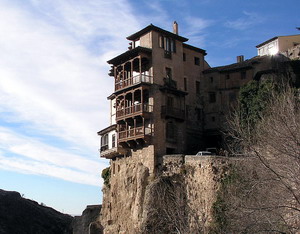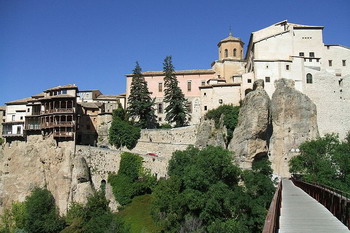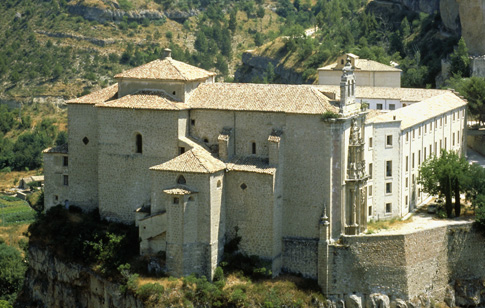Return
to Travel Guide / Home
/ Castilla-la
Mancha Guide
 Located in the autonomous community
of Castilla-la Mancha in Central Spain, this historic city sprawls across
a steep spur, the slopes of which go down into the deep rocky gorges of
the Huécar and Júcar rivers.
Located in the autonomous community
of Castilla-la Mancha in Central Spain, this historic city sprawls across
a steep spur, the slopes of which go down into the deep rocky gorges of
the Huécar and Júcar rivers.
| If you can even imagine
living in a house that quite literally hangs over the edge of a very steep
cliff, then you should visit Cuenca and its fascinating "Casas Colgadas"
or Hanging Houses.
Due to its situation in the
mountains, Cuenca is divided into two settlements, one the so-called "new"
city and the other the older town, divided by the Huécar course.
Casas Colgadas (Hanging
Houses):
The looming rocky cliffs
are the home of the Casas Colgadas, or Hanging Houses. This kind of house
was a frequent sight in the past but today, only a few remain. Those pictured
on the right, with their wooden balconies, are the most well-known of them
all. |

|
Not much is known of their
origins, although evidence shows that they existed in the 15th century
and they have been refurbished several times since then, the last renovation
being during the 1920s.
These days they are used
as council houses, individual homes, a restaurant and also the Museo de
Arte Abstracto Español (Spanish Abstract Art Museum), in Cuenca.
 A
bit of history A
bit of history
To find out how the town
got its name, it seems that while the rest of Spain was being taken over
by the Romans, Cuenca was left alone. It was only when the Arabs captured
the area in the year 714, that the value of this strategic location was
seen, and they built a fortress on the mountain-top which they named "Kunka."
In later years as the Christian forces gradually took back the country,
the name most probably evolved from that into the current city name of
"Cuenca."
The ruins of the Arab fortress,
dubbed El Castillo, can be seen in the town today, but only a tower, a
couple of stone blocks and an archway into the town remain.
There are many impressive
sights to see in the city, including Cuenca Cathedral, pictured above,
which was built between 1182 and 1270. In 1902, the façade was rebuilt
after it crumbled down, and it is renowned as being the first gothic style
cathedral in Spain.
The Puente de San Pablo (bridge
of Saint Paul) was built between 1533 and 1589, and is still in use today.
Stretching over the river Huecar's Gorge, this bridge connects the old
town with St. Paul convent. Admittedly, the original did collapse and the
current bridge was rebuilt in 1902, but it is still a historic structure,
looming 40 meters high over the gorge and supported by the remains of the
original bridge.
Sleep among history
Across the bridge can be
found the convent of Saint Paul, the original portion of which was built
in the 16th century. It took a while for the current structure to be completed
in the 18th century in the rococo style.
 The
convent was run by Dominican monks and later the Pauline Fathers, but has
now been restored to its original splendor and more and now houses the
Parador
de Cuenca, a luxury hotel. The
convent was run by Dominican monks and later the Pauline Fathers, but has
now been restored to its original splendor and more and now houses the
Parador
de Cuenca, a luxury hotel.
By the way, the government-owned
Paradores of Spain are a fascinating experience, where you can stay in
luxury in a historic building, such as a castle or palace in most regions
of Spain, and Cuenca's parador is no exception. From here the old town
is easily reachable via the St Paul bridge.
There is so much more to
see if this historic and beautiful city, including churches, ancient buildings
and beautiful plazas and parks. Why not take a few days to visit
this unusual location in the heart of historic Spain?
Return
to Travel Guide / Home
Page / Castilla-la
Mancha Guide
top
|



